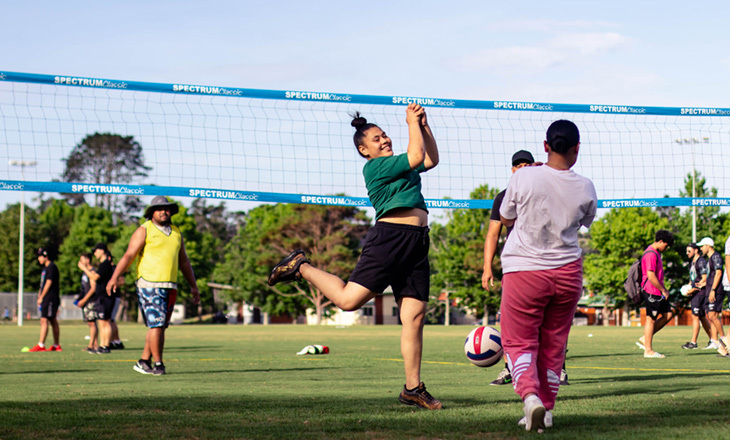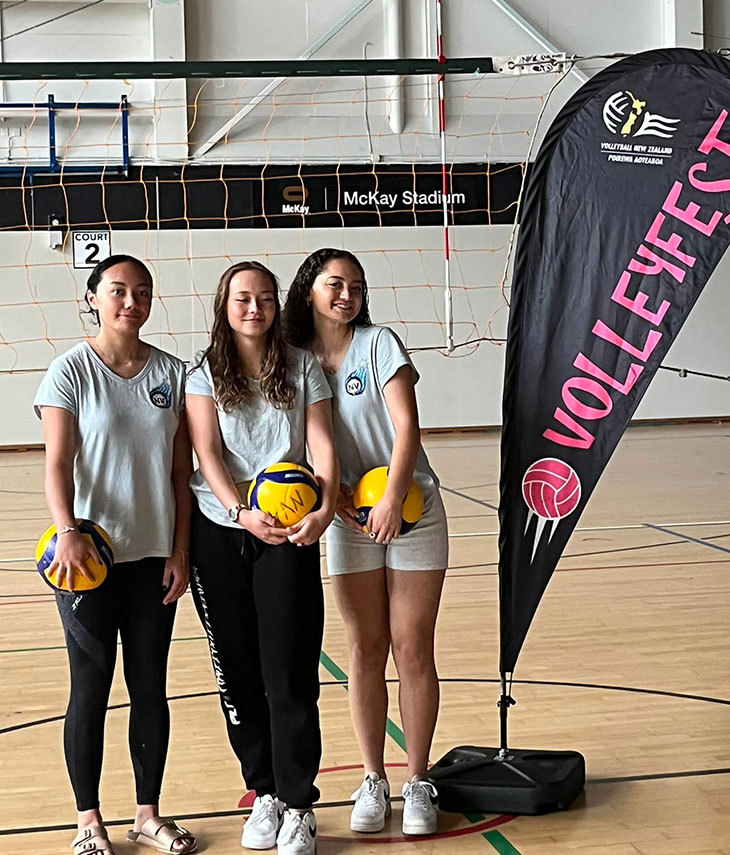Volleyfest takes sport to the people
Volleyfest takes sport to the people
Case study: Impacts of Young Women’s Activation Fund

A locally-led volleyball programme getting more young Māori and Pasifika women active with their whānau and communities
The traditional volleyball model of a single, centrally located indoor facility failed to connect with many young people in Northland communities.
So, when the chance came to deliver Volleyfest - a holistic, fun, festival programme of co-designed activities for young Pasifika and Māori women - project lead Grant Harrison decided to take the game to the people.
“Because of the portability of the equipment we weren’t limited by size,” says Harrison.
In some of the communities that we went to, there was space for one volleyball net next to a playground – and the kids all came there.”
The Volleyfest team would set up grass courts at multiple locations and found that young people would happily circulate between venues.
“We didn’t have to put up three or four nets to play. We just put up one and the kids all moved around.”
One of nine programmes supported by Sport New Zealand’s Young Women’s Activation Fund, Volleyfest includes elements of health, nutrition, well-being, and leadership development.
“For me the highlight was seeing the kids’ faces and the way that they would connect to each other.”
Volleyball New Zealand (VNZ) identified four regional associations to work with - Northland, Auckland, Manawatū and Canterbury - and enlisted the support of Dr Amy Marfell, lead of Sport Waikato’s This is ME® programme to work with the project leads.
This provided the project leads and VNZ with a range of tools to interact positively with young women by understanding key factors that can contribute to a fun and inclusive environment and build confidence and competence.
Project leads were provided with minimal guidelines, encouraging and allowing each region to take a locally-led approach to identify and meet the needs of their communities. The only requirements for Volleyfest events were that they were delivered at little to no cost, on grass, in female-only spaces, and for Māori and Pasifika participants.
Taking volleyball to the community has allowed the regions to identify and develop local leaders who can engage the community outside of the Volleyfest activations.
In Northland, Volleyfest was a perfect vehicle to provide a recreational experience for young women that they could easily access and engage with on their own terms.
Harrison formed a group made up of representatives from organisations such as Touch NZ, the Salvation Army, Whangarei Youth Sports, and the Raumanga Community Group, as well as school teachers and other community leaders that would work together to implement changes to the event that young women said they wanted.
“Essentially what came out of that was that kids wanted to do things that kept them active – not limited by the constraints of rules,” says Harrison.
“Volleyball allows you to do that. The kids can have 5-, 10-, 15-a-side – it doesn’t matter. They just love being a part of it, love playing alongside their brothers, sisters and cousins.”
Providing kai was a key part of the offering in Northland’s communities, Harrison noted.
“We didn’t need to offer prizes, the reward for being there was getting something to sustain themselves. We suspected for some of the kids who were there that would be their dinner.”
The decision to partner with other sporting codes such as touch rugby proved a major success.
“It meant we were able to offer variety to the kids,” says Harrison.
For younger participants, the idea of distinct codes and sports wasn’t important. Play was often unstructured, and could be as simple as throwing balls around and jumping over hurdles.
“The model that we challenged is that you’ve got to go into a community with a certain sport and run it – rather than go in with a whole lot of opportunities,” says Harrison. Volleyfest Northland’s freestyle delivery approach proved hugely successful, with many young women participating and going on to sign up to play club or school volleyball.
It also created a group of newly empowered youth leaders.
“When we arrive, kids rush to help set up. It is ‘how can I help, how can I help’? That is not what you’d necessarily expect,” says Harrison.
The teenagers running the events fed off the respect they were shown by the younger kids who were participating.
Some Volleyfest youth leaders are playing a wider role in sport and recreation delivery, providing the youth voice for forums such as Sport Northland’s Balance is Better committee.
“Their confidence has grown so significantly. The [older kids] manage themselves when they play. But what they didn’t realise is how much of an impact they could have on others by just showing some care and attention.
“For me the highlight was seeing the kids’ faces and the way that they would connect to each other.”
AT A GLANCE
What was the need or problem in the community?
Volleyball NZ’s research showed that young women from schools across the country were keen to try the sport – but didn’t know how to go about it due to:
- lack of participation opportunities for beginners/novices
- lack of confidence around perceived skill set needed to be successful
- opportunities that were being provided were very formal and required commitment to a team for long seasons.
What challenges or barriers existed and how were they overcome?
COVID 19 impacted delivery, with South Auckland and Northland most affected by lockdowns and gathering limits. Manawatū and Canterbury also saw reduced participation due to a fear of transmission at public events.
Regular access to indoor facilities, travel, availability of court bookings and cost were also among the barriers limiting participation in the sport by young women.
The Needs of the Auckland Volleyball Community report identified that many young women and girls wanted a safe, fun, and inclusive environment in which to experience the sport.
Key focuses include providing more participation opportunities for Māori and Pasifika women, developing leadership skills among participants and increasing coaching and refereeing capability to help ensure growth in the sport would be sustainable.
What were the key success factors – and were they driven by an innovative approach?
Volleyfest was delivered across four regions – Northland, Auckland, Manawatū and Canterbury. There were distinct differences in approaches in each region and, as such, distinct outcomes. The freedom to design their own programmes within those parameters saw each region develop unique offerings.
These included:
- Year 7 & 8 girls only Volleyfest weekly modules
- Year 7 & 8 girls only Volleyfest festivals
- Weekly community modules volleyball only
- Weekly community modules cross coded collaboration
- Cross coded collaboration community weekend festivals
- Player skill development courts
- Coach and referee development opportunities
- Youth leadership and mentorship opportunities
What outcomes were achieved?
Despite the challenges posed by COVID, Volleyfest was extremely successful. With barriers such as cost, travel, and the expectation of a high ability level reduced, there was a significant increase in female participation in communities that had not previously been exposed to volleyball.
All four regions saw an increase in participation numbers of between 20 to 35 per cent, and have seen players from the Volleyfest activations progress to joining school and club teams.
- South Auckland has seen a large increase in community members wanting to join local club competitions and set up their own teams to continue to participate.
- In Northland, key leaders in remote communities have volunteered to drive more volleyball opportunities outside of Volleyfest.
- Both Auckland and Northland have seen an increase in the number of female coaches and referees supporting youth volleyball.
- In Manawatū and Canterbury, Year 7 and 8 regular modules have been introduced for young girls.
There was also a significant increase in female participation in communities that have not previously been exposed to volleyball. This was driven by project leads who worked to decrease barriers including cost, travel, and the expectation of needing to be an experienced player.
Across the board, strong relationships have been established with local community organisations that will continue outside of Volleyfest.
What comes next?
VNZ is working with a further five associations to deliver Volleyfest in the spring/summer of 2022/23. Discussions are also underway with an additional five associations.
Through this initiative, VNZ has learned that Volleyfest is a great vehicle to engage with community, iwi, church groups and work alongside other volleyball providers to build more opportunities of informal volleyball experiences, and have layered these insights into its Strengthen and Adapt project.
VNZ and the four regional associations will continue to work with key stakeholders and utilise relationships established through Volleyfest to expand its delivery and impact in these communities.

Find out more: https://www.volleyballnz.org.nz/
